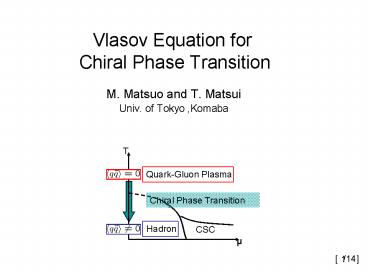Vlasov Equation for Chiral Phase Transition - PowerPoint PPT Presentation
1 / 15
Title:
Vlasov Equation for Chiral Phase Transition
Description:
Two Lorentz contracted nuclei are approaching toward each other at ... disturbs the oscillation as 'external perturbation ' [ /14] 10. Extension to O(N) model ... – PowerPoint PPT presentation
Number of Views:27
Avg rating:3.0/5.0
Title: Vlasov Equation for Chiral Phase Transition
1
Vlasov Equation for Chiral Phase Transition
- M. Matsuo and T. Matsui
- Univ. of Tokyo ,Komaba
/14
2
Chiral Phase Transition in heavy ion collision
Two Lorentz contracted nuclei are approaching
toward each other at the velocity of light.
After two nuclei pass each other,,,
Vacuum between two nuclei are excited and filled
with a quark-gluon plasma. Vacuum chiral
condensate has melted away in this region.
As the system expands, the quark-gluon plasma
will hadronize and the chiral symmetry will be
broken spontaneously again.
We have growing chiral condensate and particle
excitations
Eventually, condensate will be repaired and
particles will fly apart with a frozen momentum
distribution.
We like to formulate a quantum transport theory
to describe the final stages.
/14
3
Our Physical Picture Particle excitation by
quantizing the fields
In the past described by Classical fields
(coherent state)
(ref. Asakawa, Minakata, Muller)
Our formalism put incoherent particle
excitations by quantizing the fields
time-evolution
/14
4
Outline of the rest of this talk
I. Derivation of Coupled Equations
II. Uniform Equilibrium
III. Dispersion Relations solutions in
linearized approx.
around uniform equilibrium
IV. Open problems How the system time-evolve?
I. derivation of coupled equations to
describe evolution of non-equilibrium systems
Quantum kinetic equation for particle
excitations
Classical field equation for chiral
condensate
Coupled Eqn.
IV. time-evolution gtgt Sorry! Now Working!
III. dispersion relations solutions in
linearized approx. around uniform equilibrium
II. Apply to time-independent
equilibrium states
/14
5
Our Formalism
Heisenberg Equation of Motion for quantum fields
Separate the fields into Condensate / Non-cond.
part
Statistical average with Gaussian density matrix
odd power gt 0
4th-power decoupled into the product of
2nd-powers
Equation of Motion for the mean field
Classical field equation for condensate
Equation of Motion for fluctuation in terms of
the Wigner functions
Quantum kinetic equation for
non-condensate (particle excitations)
/14
6
A simple model phi4 model
Modelphi4 model for quantized real scalar field
Hamiltonian
Heisenberg eq. of scalar field
Gaussian statistical average
Classical mean field equation
(Non-linear Klein-Gordon eq.)
?This equation includes the effects of quantum
fluctuation
/14
7
Wigner function Quantum Kinetic Equations
Define creation/annihilation operator
(µ physical particle mass)
Construct Wigner function (quantum version of
number density distribution in phase space)
Equation of Motion for F contains other Wigner
functions
? For a static uniform system, G,Gbar can be
eliminated by the Bogoliubov tr. (corresponds to
redefinition of particle mass) .
/14
8
Quantum Kinetic Equation for ltaagt
Equation for f(p,r,t) in long wavelength limit
(quantum Vlasov eq.)
l.h.s Landau kinetic equation
Fluctuation of meson self-energy which is not
included in the particle mass
Quasi-particle energy
Mean Field potential
Relativistic drift term including the effect of
local change of particle mass
Vlasov term due to continuous acceleration
generated by the gradient of mean field potential
U
r.h.s sink/source terms due to the local
fluctuation of particle mass can not be
eliminated for a nonuniform system.
/14
9
Kinetic Equation for the Wigner function g
Equation for the Wigner function gltaagt
no drift/Vlasov term for g purely quantum
mechanical origin looks more like an equation
of a simple ocsillator with frequency 2e
Rapid oscillation between particle and
anti-particle
r.h.s Matter distribution f(p,r,t) disturbs
the oscillation as external perturbation
? If the system is static and uniform, Up0
? F and G are decoupled by Bogoliubov tr.
/14
10
Extension to O(N) model
Extend one component model to multi component
model with continuous symmetry (Chiral symmetry
SU(2)L SU(2)R O(4) )
(i1N)
N classical field equations (non-linear
Klein-Gordon eq.)
Define creation/annihilation ops. construct
NN Wigner functions
NN kinetic eqs (Quantum Vlasov equations)
/14
11
Equilibrium States
Time-independent solution of Coupled equation for
O(2) (assuming only one component of the meson
field fc0 has non-vanishing expectation value in
equilibrium )
gap equations
Difficulties
- 1st order phase transition
- Always confronted with this problem when
using mean field approximation
0
T
Tc
II. Goldstone theorem is apparently violated.
(µ1?0 µ2?0)
- We will show later missing Goldstone mode can be
- found in the collective excitations of the
system.
/14
12
Linearized Eqs. and Collective modes
Coupled non-linear eqs for condensates
particle excitations
linearization with respect to small deviations
from equilibrium solutions
(assuming only one component of the condensates
fc0 has non-vanishing expectation value in
equilibrium )
?Coupled linear eqs for these fluctuations
?N decoupled sets of fluctuations
?Dispersion relations
/14
13
N2 Dispersion relations
Dispersion relation (s-like mode) in the
direction of condensate
No collective branch gt Meson excitation
Meson excitation
Dispersion relation (p-like mode) in the
direction perpendicular to condensate
w
Massless collective mode gt Nambu-Goldstone
boson
Goldstone theorem is recovered!
/14
14
SUMMARY
- We have derived a coupled set of equations for
quantized self-interacting real - scalar field (O(N) linear sigma model) containing
equations for classical mean field and Vlasov
equations for particle excitations. - We have studied dispersion relation of
excitations and found - s-like mode with mass
- and p-like massless modes corresponding to the
Nambu-Goldstone bosons. - Open problems
- We have to solve the equations with more
realistic initial condition for final stages of
evolution of nucleus-nucleus collision. - Non-hydrodynamic collective flow may be
generated by acceleration by mean field gradient
. - This formalism gives a consistent framework for
studying these problems.
Thank you very much indeed for your
kind attention!!
/14
15
- Bose-Einstein dist.































